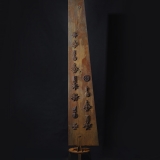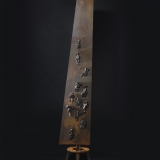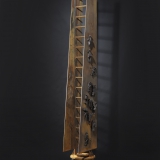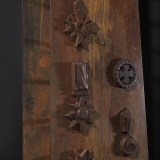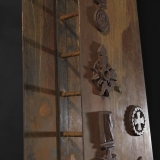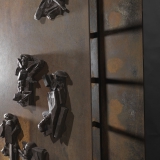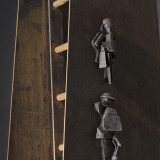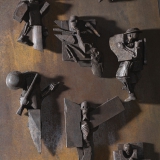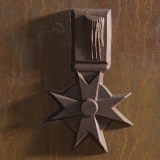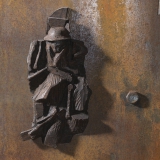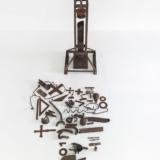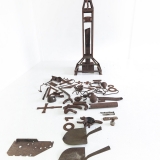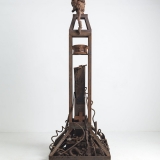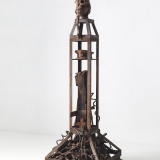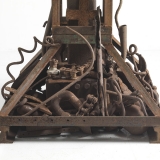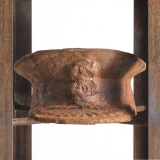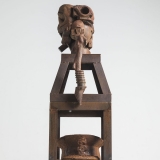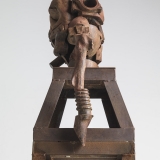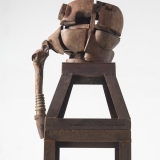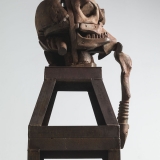FIELD MARSHAL DEATH and JACOBS LADDER
There is a difference in time of completion, (Jacobs Ladder – 2013 and Field Marshal Death – 2016) but the two are related. They are made of the same materials – steel, cast-iron and bronze. More important, each sculpture refers back to the period when I researched a section of the Northern end of the Somme battlefield, the cliffs along the Ancre Valley from Aveluy Wood to Beaumont Hamel. The research took place over several summer blocks, spread over the years 1968 to the mid nineteen seventies. The aim was observing, surveying and getting to know the ground by drawing and crude mapping as well as making written notes. Spending so much time in one place I could see where the nature of the tragedy lay, in the superior use of the defenders of both the ground and underground (the solid and largely shell-proof nature of the chalk)
2013
Steel, Cast Iron & Bronze
Edition of 3
300 cm high
Jacob’s Ladder is not a biblical reference. When I made drawings and a cardboard model for the sculpture I did not know that there was a Jacobs trench on the Ypres Salient. (The trench was located between Hooge Crater and Wieltje a little way East of Bellewarde Ridge). The steel, cast-iron and bronze sculpture was started in 2012 and completed in early 2013, but it can be seen as unfinished business looking back over forty years to the Somme Series.
I was convinced that Jacob’s Ladder was mentioned by A.P.Herbert in his poem Beaucourt Revisited, but, on looking again, I realised that I was wrong, though Herbert wrote of an equally infamous trench in the Ancre valley, Kentish Caves. Jacobs Ladder was a step-trench ascending the steep slope. This made sections of the trench exposed to German snipers on the other side of the valley. Scrim hid those moving up the trench but provided no protection against random shots or shrapnel shells.
2016
Steel, bronze, wood and
found materials
Complete Sculpture: Unique
Bronze Head: Edition of 6
230 cm high 80 cm wide
George Fullard talked frequently of ‘Poetry’ in relation to sculpture. He admired ambiguity and paradox. The joy of sculpture (like poetry) is that it can mean many things at the same time. Sources for sculpture are equally diverse.
I cannot remember which came first; the visit to the Historical Museum in Berlin or hearing Mussorgsky’s ‘Songs and Dances of Death’ on the BBC. The visit to Berlin inspired the Janus figure of George the V and his cousin Kaiser Bill – two heads with the same body. Janus is not large, about 35 centimetres in height, carved in boxwood and painted. It is a part of the ‘War Toys’ series. Field Marshal Death is much larger, made of bronze, cast iron and welded steel, the Marshal stands over two metres high.
Mussorgsky wrote his Songs and Dances of Death between 1875 and 1877. He based them on a set of poems by Arseny Golentschev Kutuzov. The four poems deal with forms of death familiar to Europeans in the Nineteenth Century: the death of a child; the dissolute student; the drunkard dancing in the snow; and finally the Field Marshal.
Field Marshal Death is an ambiguous figure sometimes male, sometimes female (the Greek Ate, goddess of death, disorder and confusion)
“I want to count my troops
Then deposit your bones in the ground.
Year after year will pass
And even the memory of you will disappear.
I will not forget and loudly above you
Will hold a feast at the midnight hour”
Clearly this is Ate gloating over her work and yet a nameless Russian critic wrote.
‘The figure of death is depicted as an officer commanding the dead of both armies. As their skeletons parade before him he pledges his enduring memory of them.”
The last line of the song describes Death as he stamps and dances on the graves of the masses killed in battle.
“You’ll never rise from the earth.”
(The Battle of the Somme between 1st of July and 18th of November 1916 caused 420,000 British casualties.)
The Songs and Dances of Death was orchestrated by Glazunov and Rimsky-Korsakov soon after Mussorgsky’s death. They were orchestrated again in 1962 by Dmitri Shostakovich
Tuesday 26th July 2016
“I am sitting in the studio looking at the pieces of Field Marshal Death. A mass of rusted steel is ready to load into our small car, I hope that it can support the weight. To transport it the frame breaks down into three large pieces. The bronze death’s-head sits on its own support that bolts to the main-frame and the mass of small rusted steel pieces surround the base. Only two pieces of these are battlefield relics. They are screw-pickets from a railway embankment between Ypres and Comines. Apart from these everything I use is either beach-combed along the Suffolk coast or farm debris from Oxfordshire.
Dismantling Field Marshal Death activates something dark and forbidding. Whatever it is, sitting here looking at all these pieces of rusty steel makes me think of the First World War (that my parents called ‘The Great War’ or simply ‘The War’).
I think of the extraordinary story of the couple, who would eventually become my parents, touring the battlefields of Flanders and Picardy in 1919 or 1920, like so many others searching for the graves of relatives and friends.
I also think of the summer of 1946 when my parents took me (aged 14) and my brother Andy (11 and a half) on a seaside holiday in Brittany. The route in the old family Ford took us from Boulogne to Rouen through various smaller towns. Like the city every one of them was destroyed by bombing. We passed through Normandy, from the Invasion coast at Arromanches through the Bocage around Caen to the Poche de Falaise. Every town, village and farm was destroyed. Through two summers the countryside had regrown to a lush green but everywhere we found the remains of mechanised battle. Tanks; guns, large and small; lorries and motor vehicles of all kinds, many of them burnt out, bright with rust competing with the black and grey of carbon. Here and there, emerging out of the long grass or woodland like some apparition, we came on a giant, a Tiger tank or a mobile gun still wearing its spring dazzle-camouflage; apple green, mauve, buff, orange or blue-grey. Superficially these monstrous machines appeared intact. They were as bright and new as the day they left the factory. When Andy and I climbed up on massive tracks and peered inside we discovered that the interior of the tank was carbonised as though by a furnace, everything inside melted and consumed, including the crew.
We, small boys in Southern England, had witnessed the war as airial combat far above our heads. We saw the devastation of bombing raids on Midland towns and on the Capital, but nothing prepared us for the wreckage in the Poche de Falaise. This was the once fertile shallow farming valley that formed a natural escape route for one of the occupying armies attempting to escape from the South. The retreating Germans were wedged between the Canadians on one side and the British on the other, with the vengeful Poles on the ridge ahead of them, cutting off their line of retreat. Every type of vehicle, including many drawn by horses, formed a massive military traffic jam into which the Canadian and British artillery poured shells large and small. The pocket became a “Killing ground” in both the military and the apocalyptic sense.
For two English boys this mass of material evidence was an example of the brutality and horror of war that we would never forget. Horror was accompanied by pity. These rusting carcasses were all that remained of those terrible and rapacious Germans we had been warned against and preached about through six years of war. The Second World War meant a constant drip-drip-drip of propaganda, exhortation and guilt. This was aimed at softening us boys up for the inevitable, to make us guilty and so willing to accept conscription: to “Do our bit for King and Country”. There was no escape from a torrent of lies, guilt-tripping and hate propaganda. When the war in Europe ended I was thirteen, a rebellious and close to unteachable adolescent. Official lies and the exhortations of our elders (non-combatants; never servicemen or women) were so much a part of our daily lives that we paid no attention. We assumed that everything we were told was a lie. Only when I read Katz und Mause, Gunther Grasse semi-autobiographical novella about childhood in Dantzig, did I understand that German kids were indoctrinated in a similar way to us. Different lies, it is true, but the same misguided principal of transforming us into hate-filled little fanatics.
Sitting here, looking at the mass of rusty steel on the studio floor in front of me, my thoughts return to the First World War (which ended 14 years before I was born) as much as the Second that I experienced personally. I think that this is because the Great War – as my parents called it – was largely static. It fixed along a line from the Belgian North Sea to the Swiss border and that Killing Zone can still be traced with little difficulty if you know what to search for. Those holes in the grazing land, the villages where not an old house or barn remains, above all the metal objects that emerge from the ground, even after a hundred years and a hundred harvests have passed. These are what archaeologists call ‘Material Culture’ but they are not like pot-shards, or fragments of statuary, or even gold ornaments. These are dangerous. You dig for them at your peril. They are also objects that are psychologically loaded.
The concept of Field Marshal Death lodged in my head for decades, before I had a name for it or any idea how I would make it, or of what materials. I only knew that it must be metal, of a similar construction to the rusting carcasses I saw in the Poche de Falaise. I wanted to create a reply to all the flag-wavers and arm-chair patriots who erect bronze statues to military psychopaths who send thousands upon thousands of brave, patient, decent young men off to their deaths. I wanted to echo the phrase used by the war-artist Paul Nash in a letter to his wife. “Thin and feeble will be my cry but may it damn the lousy souls of those who seek to prolong this war”.
It was Mussorgsky’s “Songs and Dances of Death” that gave me the title and the concept. The form emerged as I walked the fields of Oxfordshire and Gloucestershire aware almost sub-consciously of the remains of farm machinery and of skeletons of temporary buildings and also, at the back of my mind, of the young men of the County Regiments who sailed for France and Belgium and did not return.
